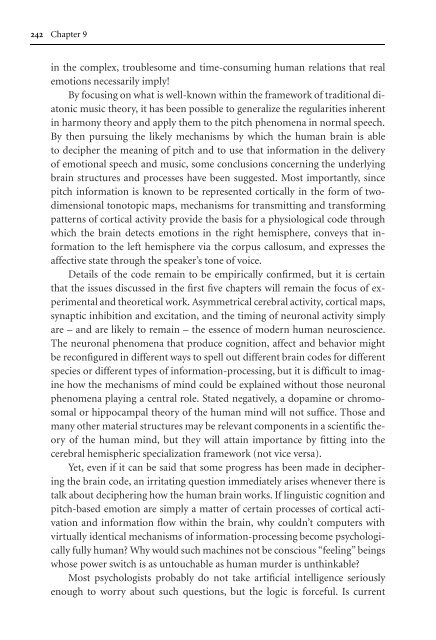Tone of Voice and Mind : The Connections between Intonation ...
Tone of Voice and Mind : The Connections between Intonation ...
Tone of Voice and Mind : The Connections between Intonation ...
Create successful ePaper yourself
Turn your PDF publications into a flip-book with our unique Google optimized e-Paper software.
242 Chapter 9<br />
in the complex, troublesome <strong>and</strong> time-consuming human relations that real<br />
emotions necessarily imply!<br />
By focusing on what is well-known within the framework <strong>of</strong> traditional diatonic<br />
music theory, it has been possible to generalize the regularities inherent<br />
in harmony theory <strong>and</strong> apply them to the pitch phenomena in normal speech.<br />
By then pursuing the likely mechanisms by which the human brain is able<br />
to decipher the meaning <strong>of</strong> pitch <strong>and</strong> to use that information in the delivery<br />
<strong>of</strong> emotional speech <strong>and</strong> music, some conclusions concerning the underlying<br />
brain structures <strong>and</strong> processes have been suggested. Most importantly, since<br />
pitch information is known to be represented cortically in the form <strong>of</strong> twodimensional<br />
tonotopic maps, mechanisms for transmitting <strong>and</strong> transforming<br />
patterns <strong>of</strong> cortical activity provide the basis for a physiological code through<br />
which the brain detects emotions in the right hemisphere, conveys that information<br />
to the left hemisphere via the corpus callosum, <strong>and</strong> expresses the<br />
affective state through the speaker’s tone <strong>of</strong> voice.<br />
Details <strong>of</strong> the code remain to be empirically confirmed, but it is certain<br />
that the issues discussed in the first five chapters will remain the focus <strong>of</strong> experimental<br />
<strong>and</strong> theoretical work. Asymmetrical cerebral activity, cortical maps,<br />
synaptic inhibition <strong>and</strong> excitation, <strong>and</strong> the timing <strong>of</strong> neuronal activity simply<br />
are – <strong>and</strong> are likely to remain – the essence <strong>of</strong> modern human neuroscience.<br />
<strong>The</strong> neuronal phenomena that produce cognition, affect <strong>and</strong> behavior might<br />
be reconfigured in different ways to spell out different brain codes for different<br />
species or different types <strong>of</strong> information-processing, but it is difficult to imagine<br />
how the mechanisms <strong>of</strong> mind could be explained without those neuronal<br />
phenomena playing a central role. Stated negatively, a dopamine or chromosomal<br />
or hippocampal theory <strong>of</strong> the human mind will not suffice. Those <strong>and</strong><br />
many other material structures may be relevant components in a scientifictheory<br />
<strong>of</strong> the human mind, but they will attain importance by fitting into the<br />
cerebral hemispheric specialization framework (not vice versa).<br />
Yet, even if it can be said that some progress has been made in deciphering<br />
the brain code, an irritating question immediately arises whenever there is<br />
talk about deciphering how the human brain works. If linguistic cognition <strong>and</strong><br />
pitch-based emotion are simply a matter <strong>of</strong> certain processes <strong>of</strong> cortical activation<br />
<strong>and</strong> information flow within the brain, why couldn’t computerswith<br />
virtually identical mechanisms <strong>of</strong> information-processing become psychologically<br />
fully human? Why would such machines not be conscious “feeling” beings<br />
whose power switch is as untouchable as human murder is unthinkable?<br />
Most psychologists probably do not take artificial intelligence seriously<br />
enough to worry about such questions, but the logic is forceful. Is current


